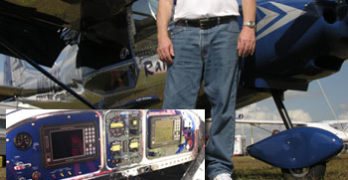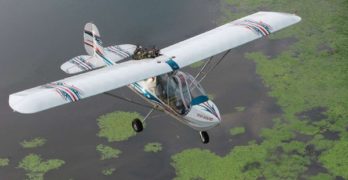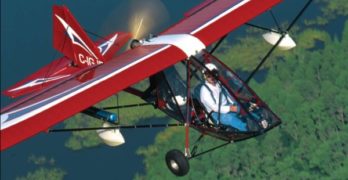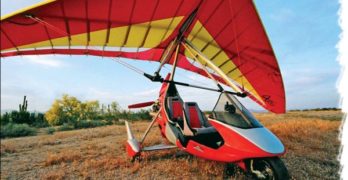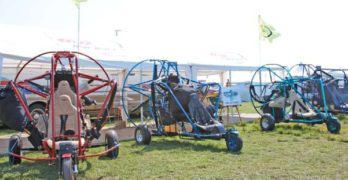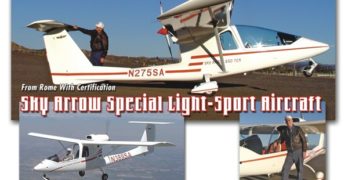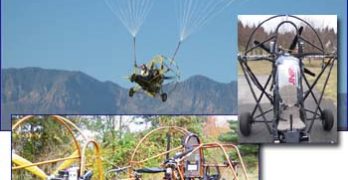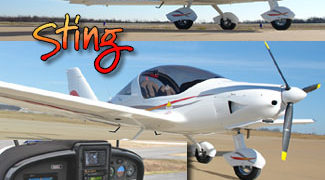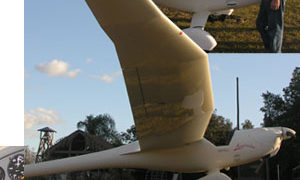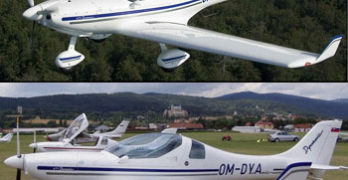Rampage looks so dissimilar to its predecessors from Skykits that it took a second glance to make the connection. While it shares the STOL wing devices with versions of the Savannah, Rampage has a sleeker look that might broaden the appeal of these short takeoff and land designs from ICP of Italy. *** For those who got to see the new model at Sebring the airplane’s lines weren’t alone to admire. Deep blue paint was used in strategic accent to highly polished aluminum on most of the fuselage; Rampage gleamed brilliantly in Florida’s warm sun. The finish was brought inside where a polished aluminum instrument panel frame contrasted with royal blue inset subpanels (photo). Skykits director Eric Giles reported that the bright metal inside had not caused reflective problems on their long flight from western Canada. *** Rampage, the fourth SLSA model for which Skykits has gained airworthiness, uses electrically deployed leading edge slats to continue the impressive performance of the Savannah models.
Search Results for : Flight Design
Not finding exactly what you expected? Try our advanced search option.
Select a manufacturer to go straight to all our content about that manufacturer.
Select an aircraft model to go straight to all our content about that model.
The Sport Hornet
Is It the First Ultralight SLSA?
Among fixed-wing airplanes, the Sport Hornet from Higher Class Aviation
may be the first ultralight-type airplane to achieve special light-sport
aircraft (S-LSA) status. Several weight-shift trikes and a few powered
parachutes also have made the jump, making declarations of meeting the
ASTM industry consensus standards.
As company owner Robert Gaither and his team made the Hornet ready for the
LSA market, the airplane was put through a series of changes resulting in the
name Sport Hornet.
From Hornet to Super Hornet to Sport Hornet
Jim Millett, of U.S. Light Aircraft,
designed the original Hornet thinking
he could improve upon the Quad
City Ultralight’s Challenger. His was
a ground-up different design that had
only the look of a Challenger. Much
of what Jim created remains on the
Sport Hornet of today, but much has
also changed, sometimes to meet
S-LSA requirements and sometimes
because it was the right thing to do.
Lightplane Offerings From Canada
The Beaver and Chinook ultralight-like aircraft are arguably two of the bestknown
lightweight designs coming from Canada. Aircraft Sales and Parts, more
commonly known as ASAP, is the company that rescued and now manufactures
and sells these designs, along with a powered parachute from its sister company,
Summit Powered Parachutes. The tale of ASAP’s involvement with the Chinook
and Beaver offers insight into ultralight progress – Canadian style.
A History Lesson
Perhaps the most famous ultralight
to come out of Canada is the Beaver.
With a reported 2,200 flying units
since the early 1980s, it’s a successful
design. However, due to corporate
missteps by the companies that
owned the brand, the Beaver series
was nearly lost. Originally, the Beaver
models were manufactured by
Spectrum Aircraft Inc. Reorganization
left the ultralight in the hands
of a company called Beaver RX Enterprises.
In 1993, that company closed
its doors and stranded thousands of
Beaver aircraft owners, along with
all the dealerships that sold and serviced
them.
A Sport Bike of the Air
First weight-shift S-LSA sets the bar high
In street vernacular, the term
“crotch rocket” refers to a lean,
lightweight, high-performance
motorcycle. Sometimes called sport
bikes, these machines have become
radically snazzy in modern years by
the addition of rakish body panels.
Sport bikes accelerate like a rocket.
They corner tightly, and they turn
heads wherever they go.
The first weight-shift trike to earn
special light-sport aircraft (S-LSA) approval,
the Air Creation Tanarg might
be compared to just such a vehicle. In
fact, that’s precisely how its French
manufacturer describes its newest
machine.
Yet, while sport bikes are touchy
and have less margin for error than
other motorcycles, Air Creation’s flying
sport bike is highly stable with predictable
handling. Compare Tanarg’s
performance to other trikes, and it
comes out as a top-of-the-line entry.
The name Tanarg comes from the
highest mountain range in the Ardeche
region of southern France, not
far from the Air Creation factory.
To Infinity…and Beyond!
The world of light-sport
aircraft (LSA) includes five
classes of aircraft-airplanes,
gliders, powered parachutes, weightshift-
control aircraft (commonly
called trikes), and lighter-than-air
aircraft (balloons and airships).
While fixed-wing airplanes may be
the most prolific, they are not the
only way for flight enthusiasts to
take to the sky. Weight-shift trikes
and powered parachutes (PPCs) are
also popular modes of flights. Each
offers a different experience to pilot
and passenger.
Some fixed-wing pilots claim
no interest in powered parachutes.
While PPCs certainly aren’t fast,
they do offer one of the best viewing
platforms in aviation and have
attracted a higher percentage of
non-pilots as buyers than any other
aviation segment. That fact alone
should cause more aviators to look
closely at them.
So far three powered parachute
companies have obtained special
LSA (S-LSA) approval for their
models. The first to achieve this
was the Summit 2 from Summit
Powered Parachutes in April 2006.
Sky Arrow Special Light-Sport Aircraft
Ultralight pilots
may not believe the Sky Arrow has achieved Part 23 certified status the same as a Cessna or Cirrus, but it has done precisely that. This sleek Italian tandem 2-seater earned European JAR/VLA certification and, after careful review, FAA gave its approval under international reciprocity agreements.
That makes the Sky Arrow something like the RANS S-7, which won approval under FAA’s last new certification program, Primary category. As a side note, the Kansas company also received its S-LSA airworthiness certificate with less challenge than companies that had not taken the earlier effort
Therefore, once FAA introduced the Light-Sport Aircraft regulation, few were surprised that the Sky Arrow could win approval. In fact, the aircraft was number 18 out of ranks that have now swelled to 40 new models approved.
Let’s forget about FAA approval for the moment and focus on the Sky Arrow’s ability to fly much like an ultralight.
Hat Trick: 3 Six Chuter Powered Parachute SLSA
Six Chuter marketing man, Doug Maas, figures it’s like soccer where three goals in a game makes a “hat trick.” With their third model gaining SLSA airworthiness before the January 31 deadline for ultralight conversions, the Washington company has earned the sports phrase. The powered parachute (PPC) producer’s newest approvals brings the total to 75 SLSA models…in less than three years! *** Boss and designer Dan Bailey planned to create three models based on common airframes. Consequently, Six Chuter has the market covered like, uh…well, like a parachute canopy. They have a “conventional” tandem (Legend XL); a rare side-by-side PPC (XT SSDC), intended as a trainer appealing to instructors who want to be alongside their student; a single seat SLSA (P103); and a Part 103 qualifier (P103UL), when flown with the Rotax 503 and few accessories. The mainline PPC Legend was derived from Six Chuter’s SR7 and Spirit models but all were redone to fully address the Light-Sport Aircraft rule.
SportairUSA to Unveil Evolved Sting S3 at Sebring
SEBRING 2008 UPDATE — Through the first three years of LSA sales StingSport from TL Ultralights has earned the #7 rank equaling an estimated 5% of the U.S. market. The new Sting S3 should push the popularity of this 98% carbon fiber low wing. S3 has a new fully-tapered wing and redesigned elevator trim. According to Bill Canino, president of SportairUSA, “Lower stall speed, shorter take-off roll, faster climb rate, balanced controls and exceptional slow flight characteristics are among the results.” Clean stall speed is 39 knots (45 mph); with full flaps stall comes at 34 knots (39 mph). Cruise speed at 75% power is 116 knots (133 mph), according to SportairUSA. “Rate of climb with the 100 hp Rotax 912S is better than 1,100 fpm and take-off ground roll has been measured at 255 feet,” added Bill. *** A basic fly-away Sting S3 including the GreenLine EMS is priced at $102,900.
Long-Gliding Lambada Soars Into Sebring 2008
SEBRING 2008 UPDATE — After watching hang gliders speck-out to 5,000 feet at Wallaby Ranch, I was caught off guard when a slippery white airplane streaked across my field of vision. Following a low pass, the bird with the gorgeous slender wings turned and approached for landing. At a hang gliding resort like Wallaby, the 30:1 Lambada quickly drew a crowd of admirers. Urban Air USA proprietor Josef Bostik flew in to show off the newly certified SLSA motorglider. *** PHOTOS: The multiple-compound wing is about as far from a rectangular Hershey Bar wing as a designer can go. At lower left, the circled red handle changes a spring-loaded prop to full feather for lower drag during soaring flight (it is not technically an adjustable pitch prop). At lower right, you see the prop at full feather. Not seen are wing spoilers that deploy with a handle between the seats similar to a flap lever.
Dynamic Spins Into SLSA; Unveiling at Sebring
SEBRING 2008 UPDATE — Sport Aircraft Works, importer and marketer of the fast-selling SportCruiser, will announce an LSA version of their Dynamic WT9. Previously, the retractable speedster (174 mph max cruise) was only available as a kit but the Slovak designer decided to pursue American SLSA certification at 550 kg (1,212 pounds). [UPDATE: Dynamic won SLSA approval on January 8th.] *** As part of their effort to meet the standards, the Aerospool Dynamic underwent spin testing by company test pilot, Jozef Chupek. “He finished this task without any undesirable control behavior,” reported the company. Testing was done in a variety of CG load and control input configurations. “All testing situations were recoverable using normal spin recovery procedures,” Aerospool added. “Spin test flights were flown with our standard aircraft; we didn’t make any special modifications [other than] safety elements such as spin recovery parachute and ejectable cockpit.” Testing was observed by members of the Slovak Civil Aviation Authority.
- « Previous Page
- 1
- …
- 111
- 112
- 113
- 114
- 115
- …
- 147
- Next Page »


